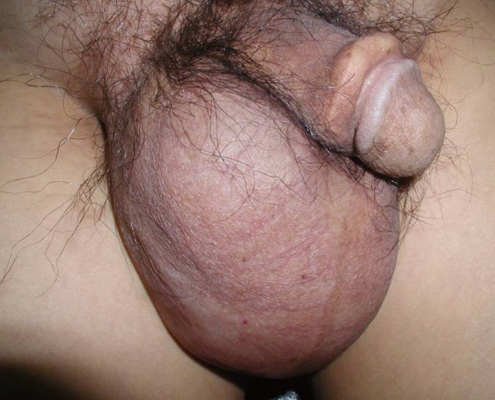Persistent Genital Swelling after Hydrocele Ligation in a Patient Receiving Continuous Ambulatory Peritoneal Dialysis
Article information
Abstract
We report a case of genital swelling in a patient receiving continuous ambulatory peritoneal dialysis. A physical examination did not identify any defect. Ultrasonography revealed a large hydrocele, and surgical repair brought resolution of the genital swelling. Two months later, however, the genital swelling had recurred and was not improved until peritoneal dialysis was replaced by hemodialysis 3 months later.
Continuous ambulatory peritoneal dialysis is an accepted treatment of end-stage renal disease. In properly selected patients, this method is suitable with minimal complications. Genital edema is a distressing complication that occurs in 4 to 10% of patients on continuous ambulatory peritoneal dialysis. It can be caused by fluid leakage from a processus vaginalis and also by extravasation of dialysate from the catheter into surrounding tissues [1]. We report a case of persistent genital edema after surgical ligation of a processus vaginalis. To resolve the edema, the peritoneal dialysis was eventually changed to hemodialysis.
CASE REPORT
A 53-year-old man with end-stage renal disease was referred for urological evaluation of massive scrotal edema of 1 month duration. Continuous ambulatory peritoneal dialysis had been performed for the preceding 8 months. The patient had no trauma, hematuria, or pain and no signs of overhydration. Blood urea nitrogen and serum creatinine levels were 71.1 and 13.3, respectively. Potassium was slightly elevated. On physical examination, the abdomen was soft and nontender. The peritoneal catheter was functioning normally. Both the scrotum and the penis were swollen and nontender (Fig. 1). The scrotum transmitted light. Ultrasonography was performed to exclude an inguinal hernia. On ultrasonography, patency between the peritoneal cavity and the right inguinal canal was revealed and there was a large hydrocele (Fig. 2). However, there was no sign of bowel hernia. Peritoneal dialysis was temporarily replaced by hemodialysis to allow the edema to subside. Surgical repair was done. During the operation, the inguinal sac was found and high ligation was performed. The patient had complete resolution and returned to ambulatory treatment uneventfully at 1 month after the operation. However, the patient revisited the clinic for recurrent scrotal and penile swelling at 2 months after the operation. Although we tried intermittent peritoneal dialysis with a low dialysate volume, the genital edema was resolved only after hemodialysis was performed about 3 months later.
DISCUSSION
Continuous ambulatory peritoneal dialysis is increasing as a common treatment for end-stage renal disease. Genital edema is a distressing complication that occurs in 4 to 10% of patients on continuous ambulatory peritoneal dialysis [2,3]. The incidence of a patent processus vaginalis at autopsy of male cadavers ranges from 15 to 37% [4]. In most patients, the genital edema is caused by leakage of fluid through the patent processus vaginalis as a result of increased pressure. During dialysis, fluid enters the sac and then leaks out into the surrounding tissues, which eventually results in edema as a result of the increased hydrostatic pressure exceeding the osmotic pressure of the dialysate. Also, genital edema can result from extravasation of dialysate from the catheter site into the surrounding tissues or from a tear in a hernia sac or processus vaginalis. Abraham et al. [2] reported a series of patients receiving continuous ambulatory peritoneal dialysis in whom genital swelling developed. One major cause of genital swelling was found to be a break in a processus vaginalis. In our case, an overlooked tear in a processus vaginalis may be the explanation for the associated penile and generalized genital swelling. Scrotal ultrasound may reveal a simple large hydrocele, but a simple hydrocelectomy would be an inadequate treatment. Peritoneograms, abdominal scintigraphy with 99mtechetium, and computed tomography (CT) scanning could be used for correct localization and accurate diagnosis [3,5]. Of these methods, CT scanning is the most useful tool and allows precise localization of the peritoneal defect [1]. In our case, the patient revisited the clinic for recurrent scrotal and penile swelling at 2 months after the operation. The genital edema was resolved only after hemodialysis was performed 3 months later.
This report calls attention to a persistent manifestation of genital swelling even after hydrocele ligation that should be included in the differential diagnosis of combined processus vaginalis tears or defects other than patent processus vaginalis. Also, the occurrence of generalized genital swelling including penile swelling in a patient receiving continuous ambulatory peritoneal dialysis suggests the existence of not only a patent vaginalis, but also a tear in a processus or hernia sac. Accurate localization of the defect leading to the genital edema is crucial. Our experience suggests that the persistent genital swelling after a hydrocele ligation in patients receiving continuous ambulatory peritoneal dialysis can be improved with a rapid change from peritoneal dialysis to hemodialysis.
Notes
No potential conflict of interest relevant to this article was reported.

